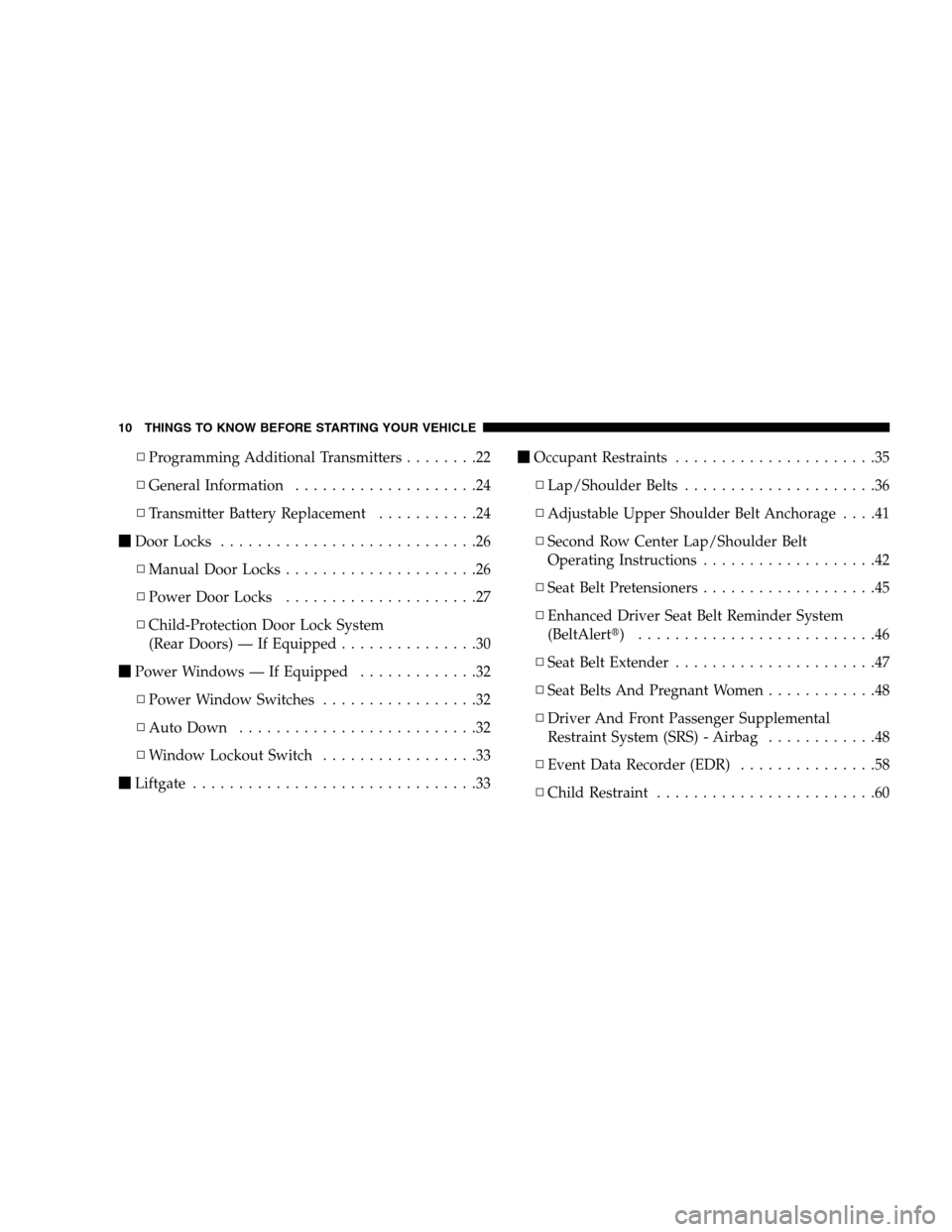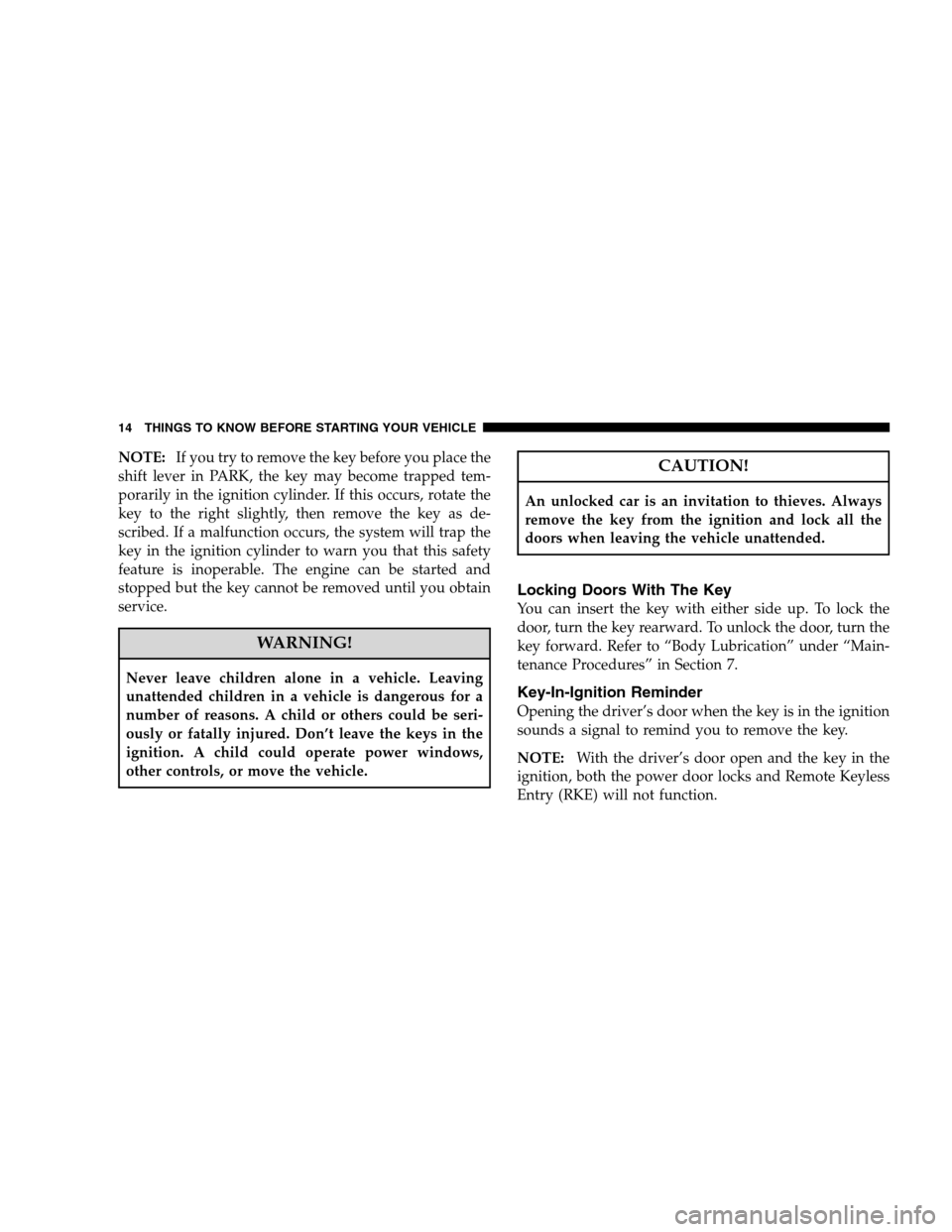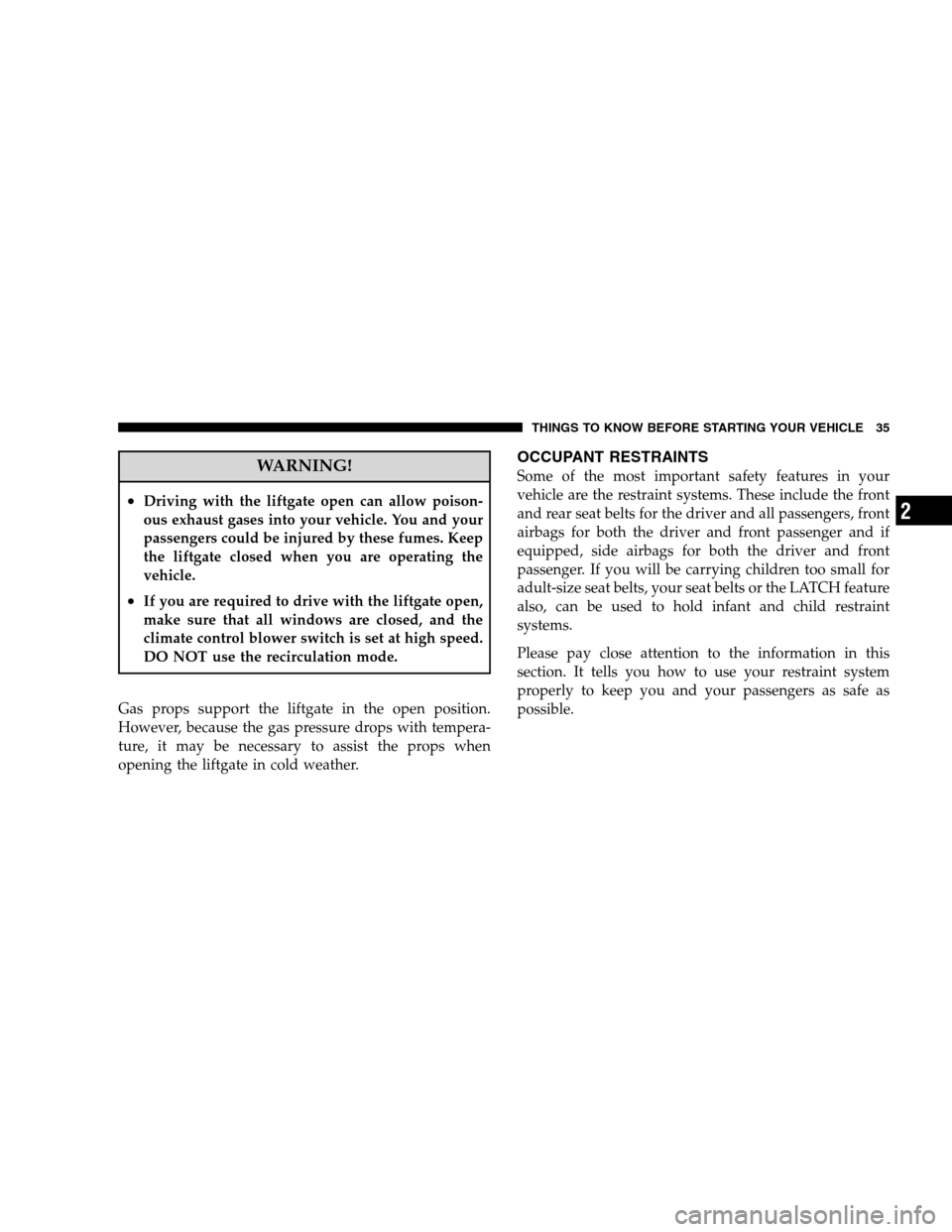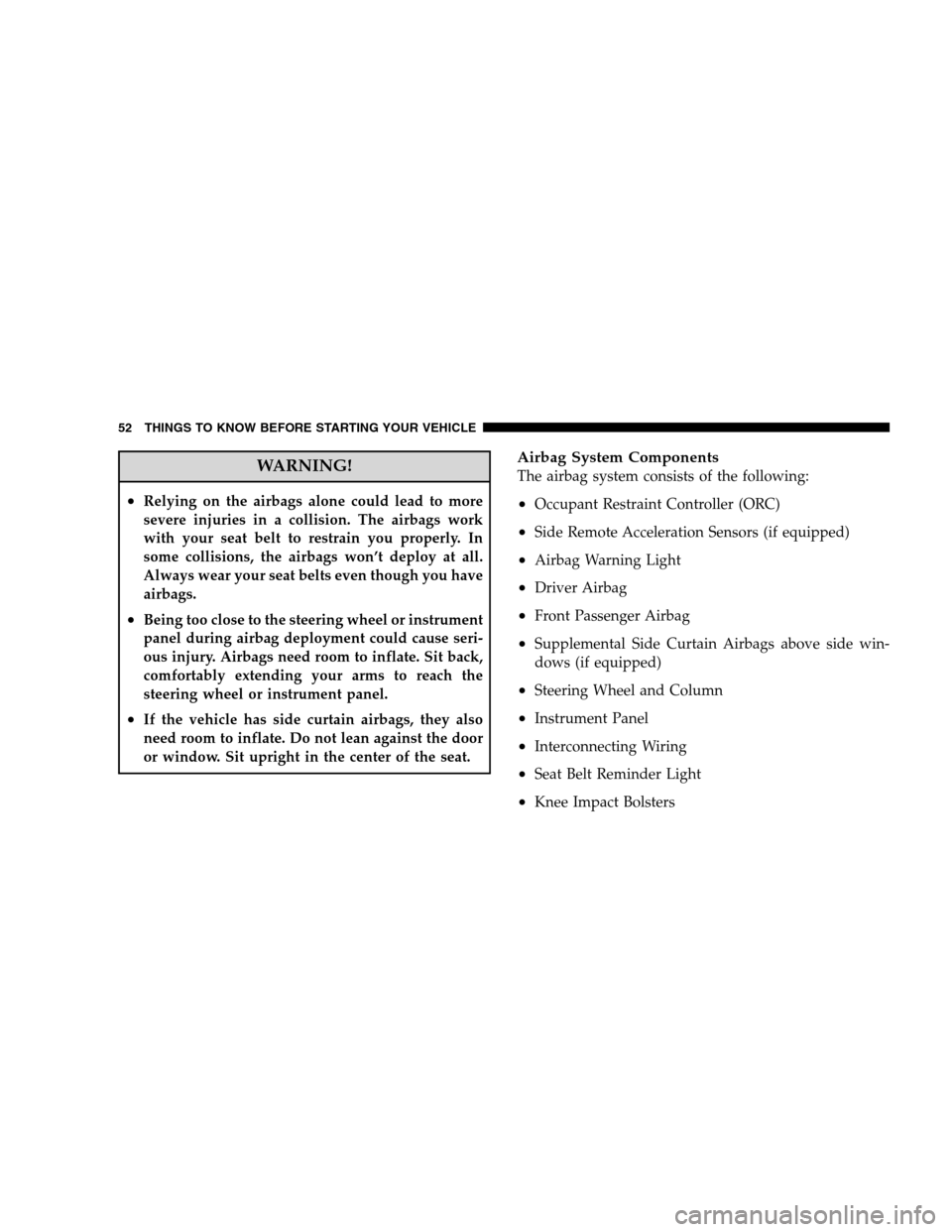Page 12 of 438

▫Programming Additional Transmitters........22
▫General Information....................24
▫Transmitter Battery Replacement...........24
�Door Locks............................26
▫Manual Door Locks.....................26
▫Power Door Locks.....................27
▫Child-Protection Door Lock System
(Rear Doors) — If Equipped...............30
�Power Windows — If Equipped.............32
▫Power Window Switches.................32
▫Auto Down..........................32
▫Window Lockout Switch.................33
�Liftgate...............................33�Occupant Restraints......................35
▫Lap/Shoulder Belts.....................36
▫Adjustable Upper Shoulder Belt Anchorage....41
▫Second Row Center Lap/Shoulder Belt
Operating Instructions...................42
▫Seat Belt Pretensioners...................45
▫Enhanced Driver Seat Belt Reminder System
(BeltAlert�) ..........................46
▫Seat Belt Extender......................47
▫Seat Belts And Pregnant Women............48
▫Driver And Front Passenger Supplemental
Restraint System (SRS) - Airbag............48
▫Event Data Recorder (EDR)...............58
▫Child Restraint........................60
10 THINGS TO KNOW BEFORE STARTING YOUR VEHICLE
Page 16 of 438

NOTE:If you try to remove the key before you place the
shift lever in PARK, the key may become trapped tem-
porarily in the ignition cylinder. If this occurs, rotate the
key to the right slightly, then remove the key as de-
scribed. If a malfunction occurs, the system will trap the
key in the ignition cylinder to warn you that this safety
feature is inoperable. The engine can be started and
stopped but the key cannot be removed until you obtain
service.
WARNING!
Never leave children alone in a vehicle. Leaving
unattended children in a vehicle is dangerous for a
number of reasons. A child or others could be seri-
ously or fatally injured. Don’t leave the keys in the
ignition. A child could operate power windows,
other controls, or move the vehicle.
CAUTION!
An unlocked car is an invitation to thieves. Always
remove the key from the ignition and lock all the
doors when leaving the vehicle unattended.
Locking Doors With The Key
You can insert the key with either side up. To lock the
door, turn the key rearward. To unlock the door, turn the
key forward. Refer to “Body Lubrication” under “Main-
tenance Procedures” in Section 7.
Key-In-Ignition Reminder
Opening the driver’s door when the key is in the ignition
sounds a signal to remind you to remove the key.
NOTE:With the driver’s door open and the key in the
ignition, both the power door locks and Remote Keyless
Entry (RKE) will not function.
14 THINGS TO KNOW BEFORE STARTING YOUR VEHICLE
Page 33 of 438
WARNING!
Avoid trapping anyone in a vehicle in a collision.
Remember that the rear doors can only be opened
from the outside when the child protection locks are
engaged.
NOTE:For emergency exit with the system engaged,
move the lock plunger up (unlocked position), roll down
the window and open the door with the outside door
handle.
Inserting Ignition Key
THINGS TO KNOW BEFORE STARTING YOUR VEHICLE 31
2
Page 34 of 438
POWER WINDOWS — IF EQUIPPED
Power Window Switches
The driver’s door panel has up-down switches that give
you finger-tip control of all four power windows. Thereis a single open and close switch on each passenger door
panel for passenger window control. The windows will
operate only when the ignition switch is turned to the
ON position, ACC position, and for up to 10 minutes
after the ignition is turned OFF or the driver’s door is
opened. Refer to “Delay Power Off to Accessories Until
Exit” under “Electronic Vehicle Information Center
(EVIC) – If Equipped” in Section 4.
Auto Down
The driver’s door window switch has an Auto Down
feature. Push the window switch past the first detent,
release, and the window will go down automatically. To
cancel the Auto Down movement, operate the switch in
either the up or down direction and release the switch.
Power Window Switch Location
32 THINGS TO KNOW BEFORE STARTING YOUR VEHICLE
Page 35 of 438
Window Lockout Switch
The window lockout switch on the driver’s door allows
you to disable the window control on the other doors. To
disable the window controls on the other doors, press the
window LOCKOUT switch. To enable the window con-
trols, press the window LOCKOUT switch a second time.
LIFTGATE
NOTE:The key that is used to start the vehicle is also
used to lock or unlock the doors and open the liftgate.
To unlock the liftgate, insert the key into the lock and
turn to the right (manual lock models only). The liftgate
can also be unlocked using the Remote Keyless Entry
(RKE) transmitter or by activating the power door lock
switches located on the front doors. The central locking/
unlocking feature (if equipped) can also be activated
from the liftgate key cylinder.
Window Lockout Switch
THINGS TO KNOW BEFORE STARTING YOUR VEHICLE 33
2
Page 37 of 438

WARNING!
•Driving with the liftgate open can allow poison-
ous exhaust gases into your vehicle. You and your
passengers could be injured by these fumes. Keep
the liftgate closed when you are operating the
vehicle.
•If you are required to drive with the liftgate open,
make sure that all windows are closed, and the
climate control blower switch is set at high speed.
DO NOT use the recirculation mode.
Gas props support the liftgate in the open position.
However, because the gas pressure drops with tempera-
ture, it may be necessary to assist the props when
opening the liftgate in cold weather.
OCCUPANT RESTRAINTS
Some of the most important safety features in your
vehicle are the restraint systems. These include the front
and rear seat belts for the driver and all passengers, front
airbags for both the driver and front passenger and if
equipped, side airbags for both the driver and front
passenger. If you will be carrying children too small for
adult-size seat belts, your seat belts or the LATCH feature
also, can be used to hold infant and child restraint
systems.
Please pay close attention to the information in this
section. It tells you how to use your restraint system
properly to keep you and your passengers as safe as
possible.
THINGS TO KNOW BEFORE STARTING YOUR VEHICLE 35
2
Page 51 of 438
The front airbags have a multistage inflator design. This
may allow the airbag to have different rates of inflation
that are based on collision severity.
This vehicle may also be equipped with side curtain
airbags to protect the driver and passengers sitting next
to a window. If the vehicle is equipped with side curtain
airbags, they are located above the side windows. Their
covers are also labeled SRS AIRBAG.
NOTE:Airbag covers may not be obvious in the interior
trim; but they will open to allow airbag deployment.
Side Curtain Airbag Location
THINGS TO KNOW BEFORE STARTING YOUR VEHICLE 49
2
Page 54 of 438

WARNING!
•Relying on the airbags alone could lead to more
severe injuries in a collision. The airbags work
with your seat belt to restrain you properly. In
some collisions, the airbags won’t deploy at all.
Always wear your seat belts even though you have
airbags.
•Being too close to the steering wheel or instrument
panel during airbag deployment could cause seri-
ous injury. Airbags need room to inflate. Sit back,
comfortably extending your arms to reach the
steering wheel or instrument panel.
•If the vehicle has side curtain airbags, they also
need room to inflate. Do not lean against the door
or window. Sit upright in the center of the seat.
Airbag System Components
The airbag system consists of the following:
•Occupant Restraint Controller (ORC)
•Side Remote Acceleration Sensors (if equipped)
•Airbag Warning Light
•Driver Airbag
•Front Passenger Airbag
•Supplemental Side Curtain Airbags above side win-
dows (if equipped)
•Steering Wheel and Column
•Instrument Panel
•Interconnecting Wiring
•Seat Belt Reminder Light
•Knee Impact Bolsters
52 THINGS TO KNOW BEFORE STARTING YOUR VEHICLE